Back in October I expressed some concern for our local fish eating birds’ ability to see their prey due to the turbidity of the water in our Wetlands caused by the Red Swamp Crayfish. I specifically mentioned our winter resident Hooded Mergansers who prey upon the Golden Shiners that live in the Wetlands. After observing the twelve or so Hooded Mergansers that have been feeding in the Wetlands for the past month, I think it’s the fish who need be concerned.
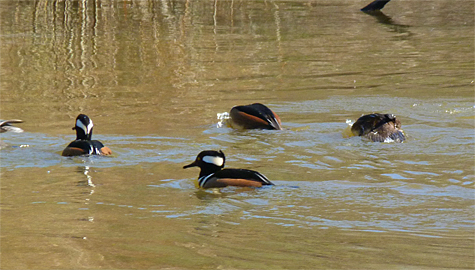
The mergansers sometimes fish in groups from two to four, but often the entire dozen can be seen steaming across the Wetlands diving for fish as they go.
Our mergs are rather shy and don’t allow a close approach, but at times I catch them near shore on the north side of the Wetlands diving among the dense tangle of willows and rushes that reside there. The fish concentrate near the cover of the willows and other plants seeking protection from what would eat them.
I’ve also noticed groups of mergs in the smartweed on the west side of the Wetlands. I know that tadpoles congregate in the smartweed for much the same reason as the fish do in the willows, protection from predators. I assumed that the mergansers that I sometimes flush from that area of the Wetlands were taking advantage of the high concentrations of tadpoles.
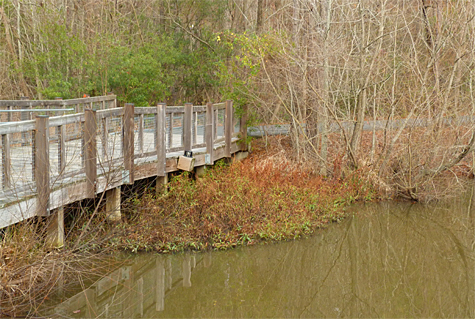
On December 9, as I walked past the area along the boardwalk where the smartweed grows I glanced over the rail, as I often do, and noticed much activity in the water below. I at first thought it was the tadpoles which usually gather in that corner of the Wetlands.
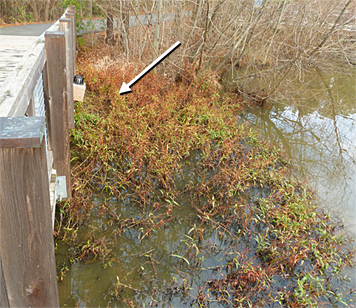
A closer look revealed hundreds of fish, Golden Shiners, all crowded up to the shore in just three to six inches of water. There were some tadpoles present, but the vast majority of the commotion was coming from fish.
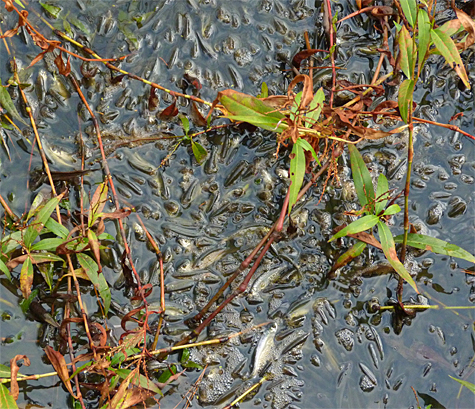
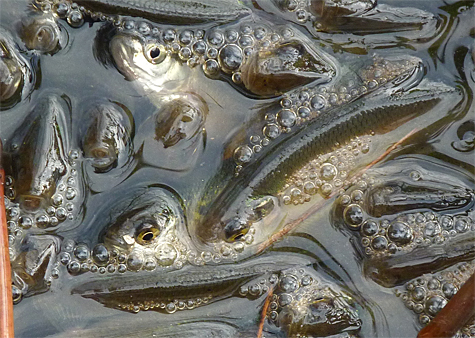
So why are these fish all piled on top of each other in this little corner of the Wetlands? The fish naturally school together and in trying to avoid being eaten by the mergansers who swim across the Wetlands in pursuit of them the school, or shoal, frantically looks for cover. Since there is little or no submergent vegetation in the Wetlands the fish seek out any cover that they can find, like the smartweed along the shore.
Once the fish find a place to hide, in this case the smartweed, they swim into it for the protection that it provides. The mergansers follow behind and push the fish further and further until they can go no further, in effect, herding them into a corner. The fish are crowded up against the shore with nowhere else to go.
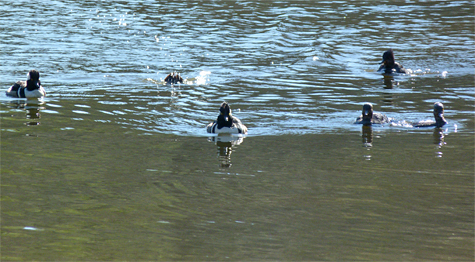
It’s a feast. For the ducks, it’s like swimming in a barrel full of fish, scooping up the fish at their leisure. For the fish, it’s like being the fish in the barrel.
The local Great Blue Heron and Belted Kingfisher also benefit from the dilemma that the fish get themselves into. After all of the Museum Guests have dispersed and gone home and there’s no one around but the wildlife, the heron and kingfisher sneak over for a meal too.
In a moment of weakness I scooped up some of the fish in a net and released them into deeper water. I felt bad for the fish. It’s difficult sometimes to see an animal in distress and not lend a hand. But, by helping the fish I was making it more difficult for the birds. And besides, those fish got themselves into that mess, they should get themselves out of it, although I doubt that they will. Why, I’d bet that the fish that I caught in the net swam right back into the smartweed
after being released.
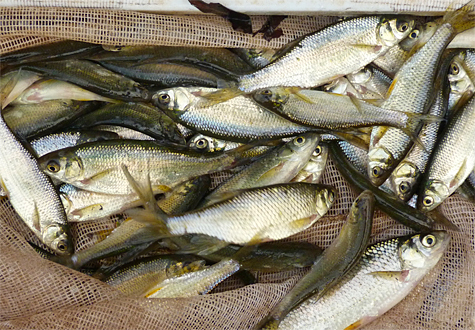
An added benefit of this fish story is that I was able to get close looks at the fish. All of the fish in this school were about four to five inches in length. They were all golden shiners, so far as I know the only species in the Wetlands. The fish, being the size that they are, are all sexually mature. And, if they aren’t eaten first, each has the potential of laying 200,000 eggs throughout its lifetime. That’s a lot of future shiners!
That pond could use a few Micropterus salmoides atop the food chain.
Glad you brought that up Larry.
I often hear suggestions about stocking the Wetlands with various species of fish. But I like the fact that whatever wildlife that currently resides in the Wetlands has gotten there on their own power, although I think that the shiners got an assist from the waterflowl. I’m not exactly sure how the crayfish got there but that’s a different story (they can, and do, walk).
I also think that there would not be as many species of frogs and toads that come to the water to breed each year if there were bass or some other predator swimming around in the Wetlands. I’ve seen or heard 13 different species of those amphibs, eight or nine of those are solid breeders, although the crayfish may have changed that, we’ll have to wait and see this coming spring/summer.
It would be fun to see some bass and other sunfish in the water though. Maybe they would keep the crayfish numbers down….
Anna: “Freeeeeeeee Willy!!!”
Thanks Anna via Meredith.
The rain the other night helped give the fish a little more “fin” room (the water level is higher) but they’re all still crowded into the corner.
Thanks for yet another excellent, and educational post Greg!
Thank you for your comment, and for reading the journal.
It’s good to know the crayfish haven’t totally upset the cycles in the Wetland.